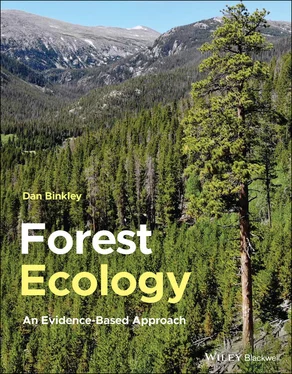Dan Binkley - Forest Ecology
Здесь есть возможность читать онлайн «Dan Binkley - Forest Ecology» — ознакомительный отрывок электронной книги совершенно бесплатно, а после прочтения отрывка купить полную версию. В некоторых случаях можно слушать аудио, скачать через торрент в формате fb2 и присутствует краткое содержание. Жанр: unrecognised, на английском языке. Описание произведения, (предисловие) а так же отзывы посетителей доступны на портале библиотеки ЛибКат.
- Название:Forest Ecology
- Автор:
- Жанр:
- Год:неизвестен
- ISBN:нет данных
- Рейтинг книги:5 / 5. Голосов: 1
-
Избранное:Добавить в избранное
- Отзывы:
-
Ваша оценка:
- 100
- 1
- 2
- 3
- 4
- 5
Forest Ecology: краткое содержание, описание и аннотация
Предлагаем к чтению аннотацию, описание, краткое содержание или предисловие (зависит от того, что написал сам автор книги «Forest Ecology»). Если вы не нашли необходимую информацию о книге — напишите в комментариях, мы постараемся отыскать её.
Forest Ecology
An Evidence-Based Approach Forest Ecology: An Evidence-Based Approach
Forest Ecology: An Evidence-Based Approach
Forest Ecology — читать онлайн ознакомительный отрывок
Ниже представлен текст книги, разбитый по страницам. Система сохранения места последней прочитанной страницы, позволяет с удобством читать онлайн бесплатно книгу «Forest Ecology», без необходимости каждый раз заново искать на чём Вы остановились. Поставьте закладку, и сможете в любой момент перейти на страницу, на которой закончили чтение.
Интервал:
Закладка:
14 CHAPTER 8: Forests Across SpaceThe Three Most Important Things for a Tree Are Location, Location, and Location How Small Can a Forest Be? Forests May Be Divided Into Stands, But Not All Forests Are Structured As Distinct Stands People Engage with Forests by Defining Areas of Interest Larger Plots Contain More Species Vegetation Differs Between Locations Space Has Another Dimension for Animals Differences in Forests Usually Increase with Distance, But Not Always Location Matters Both Locally and Regionally Resource Use Varies Across Landscape Gradients Mind the Gap: Spatial Patterns of Trees Within Forests Modify Resource Supplies The Ecology of Gaps is Not Binary The Ecology of Gaps and Edges Affects Animals, and Is Shaped by Animals The Location of Each Tree Allows a Wide Range of Assessments of Forest Structure and Processes Forest‐Level Information Can Be Dissected Down to the Level of Individual Trees Riparian Forests Are Special and Important, for Different Reasons in Different Forests Spatial Patterns Are Important, Even in the Most Uniform Forests Forest Classification Is Different in the Twenty‐First Century Ecological Afterthoughts: When It's Not About the Trees
15 CHAPTER 9: Forests Through Time Sometimes a Classic Story Comes True Long‐Term Experimental Forests Provide Knowledge at the Scale of Tree Lifetimes When Recorded History Is Not Enough, Tree Rings Can Provide a Record of Both Age and Size Dendrochronology Developed Because There Are No Canals on Mars Dendrochronology Can Explain Past Forest Structure and Dynamics Darwin's Ideas Contributed Very Little to Early Ideas of Forest Change (Unfortunately) Chronosequences Are a Shortcut to the Future, But They May Be Unreliable Strong Chronosequences Require Large Numbers of Replicates Growth Always Declines in Old Forests People Change How Forests Change Over Time Time Scales of Forests and Human Planning Do Not Always Match Over the Long‐Term, Forests Have Not Changed As Predicted Ecological Afterthoughts
16 CHAPTER 10: Events in Forests It's Remarkable That Trees Can Stand Up to Strong Winds Tree Stems May Break or Uproot Storms Blow in with a Wide Range of Wind Speeds Storm Impacts Can Be Severe in Local Areas Storms that Are Severe Enough to Be Named Are Strong Enough to Topple Vast Numbers of Trees How Large an Area Can Be Covered by a Single Storm? How Massive Can a Storm's Impact Be? When Will the Next Storm Come? The Next Storm Will Be Different Than the Last One Trees Provide the Dominant Structure of Forests, But Small Insects Can Play a Very Major Role How Do Tiny Insects Manage to Kill Large Trees? Which Trees Are Most Vulnerable to Mountain Pine Beetles? Which Forests Are Most Susceptible to Mountain Pine Beetles? Mountain Pine Beetle Impacts Are Consistent When Scaled Up to Regional Areas Tree Death Alters Environmental Conditions at Local Scales, But Less at Watershed Scales Why Don't Beetles Kill More Trees? Is This a Healthy Forest? Forests Often Thrive When Insects Kill Trees Should Forests with Lots of Beetle‐Killed Trees Be Logged? Other Dynamics of Forests and Beetles Occurred Across the Region Too Other Forests and Other Insects Have Other Stories Tree Diseases Are Reshaping Forests in a Globalized World Major Events May, or May Not, Influence the Probability of Other Major Events Events in Combinations Can Have Drastically Different Legacies Ecological Afterthought: The Ecology of Avalanches
17 CHAPTER 11: Events in ForestsForest Growth Sets the Stage for Rapid Return to Chemical Equilibrium Thick Bark Protects Cambium from Heat The Post‐Fire Forest May Be Dominated by Resprouting Vegetation Post‐Fire Environments Can Be Good for Seedling Establishment The Spatial Scale of Forest Fires is Important, But Not Simple Most Forest Fires Are Small, Though the Uncommon Large Fires Have Great Impacts Fires Burn Differently at Different Places Periods of Gradual Change Are Punctuated by the Large Changes from Fire Events Typical Fire‐Free Periods Within Forest Types Vary Across Sites and Over Centuries When Fire‐Free Intervals Get Longer, Forests Get Denser The Spatial Aspects of Fires Also Include Patterns Within Burned Patches Fire Ecology Might, or Might Not, Be Described with Fire Regimes Fires Change Soils Fires Generate Erosion in Areas That Burn, with Sediment Deposition Downslope Erosion After Fire is Usually Not a Problem, But Sometimes It's Very Severe Each Species of Animal Has a Different Response to Forest Fires Fires Interact with Other Major Events in Forests Ecological Afterthoughts: How Do Slow Changes in Forests Shape the Effects of Fires?
18 CHAPTER 12: Events in Forests Harvesting Is the Third Largest Forest Event Across the Planet Few Forests Are Plantations, But Plantations Provide Most of Our Wood Deforestation Can Be Tallied from Government Reports, or from Satellites Human Influences on Forests Have a Spectrum from Low to Very High Tree Farms Are All About Production, Not Broader Ecological Features How Sustainable Are Tree Farms? Managed Forests Come in a Variety of Systems Rotational Forests Have Birthdays Understories and Overstories Interact Through a Rotation Continuous Cover Forests Have no Birthdays, and Less Change Tree Growth Is Faster in Rotational Forestry than in Continuous Cover Forestry Management of Unmanaged Forests May Seem Like an Oxymoron How Does Retaining Trees Influence the Next Forest After Logging in Unmanaged Forests? Harvesting Is the End of the Line for Some Trees and Forests, and the Beginning of the Next Forest Harvesting Is Not the Only Big Event that Happens in Managed Forests Can Forests Remove Enough CO 2from the Atmosphere to Save the Planet? Ecological Afterthoughts: What's Next for These Forests?
19 CHAPTER 13: Conservation, Sustainability and Restoration of Forests Conservation, Sustainability and Restoration Build Values, Ethics, and Esthetics onto a Foundation of Forest Ecology Conservation, Sustainability and Restoration Are About the Future Why Do Species Go Extinct, and How Can This Be Prevented? Conserving Old Forests Is Important, but Old Forests Do Not Last Forever Conservation and Sustainability Have Similarities Restoration Comes into Play When Conservation and Sustainability Have Not Been Achieved The History of a Forest Might Be Read in Reports, in Photographs, in Trees and Remnants of Trees Clues to the Past Structure of Forests Lurks in Tree Rings, Stumps, and Logs What Does It Take to Restore a Forest? Many Forests Have Reestablished Following Agricultural Land Use Forest Reestablishment May Be Faster with Planting, and Contain More Desirable Species Forest Reestablishment Leads to the Redevelopment of Forest Soils Reestablishing Forests in the Absence of Soils Is a Major Challenge, Requiring Insights and Money Management Can Shift Forests Away from Undesirable Conditions Two Key Ideas Connect Forest Ecology with Conservation, Sustainability, and Restoration Ecological Afterthoughts: Restoring Forests May Be About Restoring Non‐Tree Vegetation
20 CHAPTER 14: Forests of the Future Forests Have Already Changed, and Continue to Change Can Invasions Be Predicted? Some Forests Are More Invasible Than Others Not all Invasive Species Are Alike: Identity Matters Plantations of Non‐Native Trees Can Lead to Invasions Biological Control May Help Limit Invasive Species Genetics Matter The Future Is Certain to Be Warmer, with More CO 2in the Atmosphere If Droughts Increase, Which Forests and Trees Will Show Increased Mortality? Changing Climates Will Change the Distribution of Species Fires Have Always Been Important in Forests, and Fires May Become More Important People Will Contribute to Shaping Future Forests All These Factors Will Interact to Shape the Dynamics of Future Forests Rocket Science Can Get You to the Moon, but Pocket Science Leads to Better Outcomes in Forests The Core Framework Actually Needs a Fourth Question Ecological Afterthoughts: Growing Meaning in Forests
Читать дальшеИнтервал:
Закладка:
Похожие книги на «Forest Ecology»
Представляем Вашему вниманию похожие книги на «Forest Ecology» списком для выбора. Мы отобрали схожую по названию и смыслу литературу в надежде предоставить читателям больше вариантов отыскать новые, интересные, ещё непрочитанные произведения.
Обсуждение, отзывы о книге «Forest Ecology» и просто собственные мнения читателей. Оставьте ваши комментарии, напишите, что Вы думаете о произведении, его смысле или главных героях. Укажите что конкретно понравилось, а что нет, и почему Вы так считаете.












